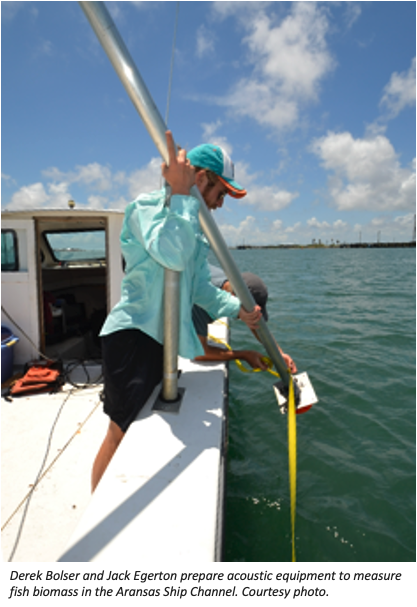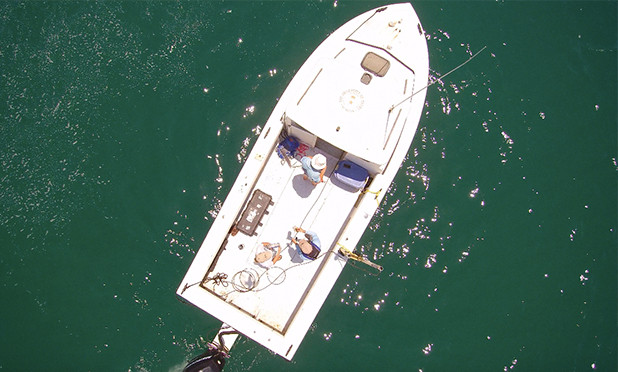 The creation of shipping channels for industry has, as a byproduct, also created an important habitat for fish – both in habitat for spawning aggregations and providing a refuge during extreme weather. New research published in Estuaries and Coasts presents evidence of how fish respond to changes in weather and water conditions. This data also presented new and useful information on potential optimal seasons to reduce the impact of channel disturbances, such as dredging, to fish populations. Development activities would be the least impactful when temperatures and salinities are moderate and frontal systems are not expected.
The creation of shipping channels for industry has, as a byproduct, also created an important habitat for fish – both in habitat for spawning aggregations and providing a refuge during extreme weather. New research published in Estuaries and Coasts presents evidence of how fish respond to changes in weather and water conditions. This data also presented new and useful information on potential optimal seasons to reduce the impact of channel disturbances, such as dredging, to fish populations. Development activities would be the least impactful when temperatures and salinities are moderate and frontal systems are not expected.
The entrances of shipping channels on the Texas coast have long been known as hotspots for fishing and bottlenecks for fish movement. These channel inlets are very difficult to assess fish use due to the ship traffic, low visibility, and high currents. Researchers overcame the sampling difficulties presented by using a scientific echosounder (similar to SONAR) to measure the total amount of fish in the water (aka biomass), data sondes to measure environmental parameters such as water temperature and salinity, and buoy data to capture weather parameters like barometric pressure at the inlet of the Aransas Ship Channel. The echosounder data was used to estimate fish biomass for species that don’t live on the bottom (e.g., mullet, menhaden, some red drum and seatrout). They then used statistics to explain trends in fish biomass with trends in the environment and provided context to what they found by relating biomass-environment relationships to adjacent fish surveys from Texas Parks and Wildlife Department’s bay bag seine surveys and surveys of fish cleaning stations.
Fish biomass was the most impacted by temperature and researchers found that higher fish biomass in the channel inlet was associated with extreme low and high temperatures. Changes in barometric pressure indicating frontal systems (e.g., cold fronts) was also found to explain why scientists observed higher fish biomass at some times. Both relationships between fish biomass and temperature and frontal systems are likely because the channel inlets act as a refuge or conduit to deeper offshore waters. The scientists think that the deep depth of the channel inlet and the jetties that protect it reduce impacts from physical wave action and lead to slower changes in temperature and salinity when extreme events occur compared to the shallow bays in the area.
These data provide valuable information for resource managers to assess the potential impact of channel activities on many fish populations. The authors note the importance of the coexistence of two large economic drivers in the South Texas region of recreational fishing and shipping. “Recent proposals for channel deepening, widening and installation of a desalination plant and Very Large Crude Carrier (VLCC) terminal at Harbor Island on the bayward end of the Aransas Channel Inlet may disrupt this important area and could have far-reaching consequences, so making inferences on optimal and suboptimal timing for these activities is critical,” said lead author Dr. Derek Bolser, who conducted this work as a graduate student at UTMSI and is now the National Fishery-Independent Survey Science Coordinator for the NOAA National Marine Fisheries Service. In particular, Bolser and co-authors cite that disturbances in the Aransas Channel Inlet (e.g., dredging and construction, shipping traffic) are likely to be most impactful to fishes that do not live on the bottom when temperature and salinity are low (< about 60 °F and < about 28 psu) and frontal systems are likely to affect the area (barometric pressure increase > c.a. 3 millibars (mb) or decrease > 7 mb over 24 h).
Bolser conducted this work with colleagues Jack Egerton, Philip Souza, Jr., Austin Richard, Laurel Diaz, and Brad Erisman of UTMSI (Egerton currently works for Echology Ltd. and Erisman currently works for the National Marine Fisheries Service), and Zachary Olsen of Texas Parks and Wildlife Department. This project is supported by The Texas State Aquarium Wildlife Care and Research Grant, The University of Texas at Austin Hornraiser program, National Academy of Sciences – Gulf Research Program and multiple graduate student fellowships.









